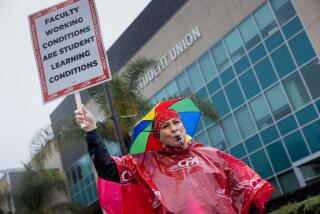Players to Vote on Their Season
- Share via
Suggesting this will be a week to remember, the NBA and its players charged into the stretch, brandishing threats to dispense with one another anew.
Three days before his so-called “drop-dead date,” Commissioner David Stern and his deputy, Russ Granik, climbed on their highest horses and rattled their sabers so loudly, the 430 members of the union, scattered from Maine to Mexico, would hear of it.
Stern talked of rebuilding with “replacement players” and appeared to invite the players to arise and renounce the advice of their union’s leaders.
Stern also seemed to suggest that if he shut the league down, any players who wanted to leave their union and rejoin the NBA next fall would be welcome.
Granik all but sneered at the union’s latest offer--which seemed to narrow the differences on major issues--terming the sides still “far, far apart,” saying it offered little new.
“We had a conference call of our labor relations committee,” Granik said, “and after going through the union’s proposal in detail, [it] voted unanimously to recommend to the board of governors on Thursday that the 1998-99 season be canceled and put together plans for the 1999-2000 season.”
Meanwhile, union head Billy Hunter went on the Larry King show on CNN and announced dramatically he was accepting Stern’s dare to let the players vote.
“We’re going to bring the players in [to New York] to vote Wednesday,” Hunter said. “Every player. We’re going to have them vote to support the recommendation of the negotiating committee. If they elect to go against the recommendation, we have to live with that.”
They would also be voting, in effect, on the NBA proposal the committee has rejected. Stern has mailed copies to players and encouraged team officials to talk to them.
However, several team officials reported--anonymously, lest they incur $1-million fines--making little headway with their players, who clearly don’t look to them for guidance on labor issues.
Yet to be decided, Hunter said, was whether this ballot will be secret. Previous ones were taken openly in hotel ballrooms. Even agents who are union loyalists acknowledge that in such settings, star players have a strong impact, or, put another way, intimidate the little guys.
In any event, the union’s star-dominated negotiating committee will not shrink from giving its opinion.
“Before we vote, we’re also going to educate them,” union President Patrick Ewing said. “We’re going to give them the pros and cons, so they can make an educated decision.”
The union seemed to make concessions over the weekend, moving close to NBA numbers on important issues.
In the revenue split, for example, where the league was at 53%-53.5%-54% in years four, five and six, the union dropped to 55-56-57.
This represents a total difference of 7.5%. Because each percentage point represents about $30 million, this means they are $225 million apart--over the entire six years of the contract.
This breaks down to $1.3 million per team per year. Assuming the union is prepared to split the difference, this doesn’t look like a deal-buster.
Nevertheless, Granik said it was.
In the all-important caps on high-end players, the union moved to $9 million (to the NBA’s $8.75 million) for players with six years’ experience; to $11 million (to $10.5 million) for players in years seven to nine, and to $15 million (to $12.25 million) for 10-year veterans.
Stern pooh-poohed it as if he’d found it scrawled in chalk on the sidewalk.
“My job as commissioner,” Stern said, “is to sometimes ignore the wishes of both sides and have a meeting when neither side wants one. But in order to do that, I would have had to see a proposal that reached for ours.
“Instead, in many ways it went backward. In light of their so-called final proposal, it [another meeting before Thursday] doesn’t seem likely at all.”
So far, we’ve had the league’s “final” offer, the union’s “last” offer, and a “drop-dead” date on which nobody may die.
In 1995, the NHL, run by Stern’s former counsel, Gary Bettman, declared a drop-dead date, canceled it during a final marathon session and reached a deal several days later.
“If a deal was done on the 9th or 10th, I’m sure David wouldn’t say that just because we didn’t do it on the 7th, the season is over,” said the Knicks’ Herb Williams, a member of the union’s negotiating committee.
“It’s a business and sometimes you have to posture.”
You don’t say.
(BEGIN TEXT OF INFOBOX / INFOGRAPHIC)
Closer Than They Think
The players’ union and the NBA owners claim to be far apart on an agreement to end the lockout, but they are actually close on the two key issues. A look:
1. Larry Bird Exception: This rule allows teams to ignore the salary cap and re-sign a veteran player at any price. The league and players are split on the maximum salary a player can make, depending on that players’ experience:
*--*
Experience League Union 0-6 years in league* $8.7 million maximum $9 million 7-9 years** $10.5 million $11 million 10+ $12.25 million $15 million
*--*
*--Union proposal is 0-5 years; **--Union proposal is 6-9 years
*
2. Revenue Sharing: The league and players are very close to agreement on how to split revenues in years four, five and six of the agreement. A look:
*--*
Year League Union Year 4 53% to players 55% Year 5 53.5% to players 56% Year 6 54% to players 57%
*--*
More to Read
Go beyond the scoreboard
Get the latest on L.A.'s teams in the daily Sports Report newsletter.
You may occasionally receive promotional content from the Los Angeles Times.










